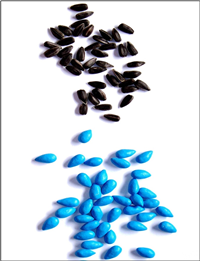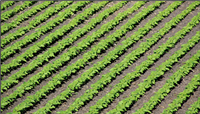Growers Aim for Optimum Singulation, Improved Seed Spacing & Plant Stand
 You may not wear a coat during a warm spring day while planting sunflower; but might your sunflower seed placement and final plant stand benefit from having a “coat” while those seeds are being deposited into the soil? That’s the basic concept behind pelleted seed.
You may not wear a coat during a warm spring day while planting sunflower; but might your sunflower seed placement and final plant stand benefit from having a “coat” while those seeds are being deposited into the soil? That’s the basic concept behind pelleted seed.
While the pellet coating will add to the grower’s seed costs (the actual percentage varies by company), numerous producers who’ve tried it believe the option is worth the extra expense.
Jeff Oberholtzer is one of them. The north central North Dakota grower (and former National Sunflower Association board member) first experienced pelleted seed when planting a seed plot several years ago. Since then, “we’ve used pelletized seed whenever it has been available” for his chosen hybrids, he affirms.
“With pelletized seed, we have close to 99% singulation,” Oberholtzer says, “which has allowed us to have better emergence and plant stand.” He adds that seed treatment protective impregnated within pelleted seed coatings “also might be more available around the roots, since the coating has to [split] before the seed can germinate.”
Matt Swenson of Walcott in southeastern North Dakota — a current NSA board member — says he planted pelleted sunflower seed this year “to get better seed placement and emergence.” Swenson was very satisfied with his 2025 emergence and plant stand. He also believes the more-equidistant plant stand and canopy coverage aided in suppressing later-emerging weeds not managed by his post herbicide program.’
Both Oberholtzer and Swenson intend to plant pelleted sunflower seed again in 2026 if the option is available for their preferred hybrids.
Garrett Driver is North American supply chain manager for Nufarm (formerly Nuseed), one of the companies offering the pellet option on select sunflower hybrids (sometimes just one or two per season). Driver sees homogeny of seed size in the bag and more-accurate seeding rates as two key benefits. “There’s certainly more space on a pelleted seed for additional treatments as well, which can be a benefit when adding more actives or micronutrients,” he says.
Nufarm has compared pelleted sunflower to nonpelleted in a number of trials across differing geographic areas. Driver says emergence rates have been very similar between the two types in their tests. However, “we have seen near-perfect seed placement with the pelleted product — and that, in turn, gives us more-healthy plants, more-robust stalks and more-uniform head size, which in turn [leads to] better standability, more-uniform harvesting and more yield.”
While not every grower who has tried pelleted sunflower does so a second or third season, Driver says that in Nufarm’s experience, “more often than not, growers who purchase pelleted seed do return the following season.”
 Other than the added cost, are there any downsides to using pelleted seed?
Other than the added cost, are there any downsides to using pelleted seed?
“The one negative that can occur is flaking or ‘dust off’ if seed is handled roughly or undergoes significant environmental impacts such as hot and cold, with humid and dry cycles causing coating to become deteriorated and flake off a kernel,” Driver says. “[But] proper timing, handling and use of the pelleted seed can prevent that from occurring. When seed is built up and handled correctly — and then planted timely — there aren’t any issues with flaking or dust off.”
Grower Jeff Oberholtzer opines that “the one drawback to pelleted seed so far is that it cannot be returned. And, it is hard to find any extra bags if you end up needing more seed.”
Kevin Bigger has a long track record with pelleted seed — especially with sugarbeets, an industry where pellets are used ubiquitously across U.S. and Canadian growing regions. Bigger serves as sales manager of the Fargo Business Unit for Germains Seed Technology, a UK-based company whose primed, pelleted and filmcoat products are used on numerous crops around the globe.
Germains’ Prosun® is a seed pellet polymer developed specifically for sunflower. The smooth coating is designed to enhance the enlarged seeds’ flow through precision air planters, resulting in improved seed placement. Prosun is added to the seed delivered by hybrid suppliers to Germains’ Fargo, N.D., plant. “We use rotary coaters, the same as for sugarbeets,” Bigger explains. “We typically receive the seed with the seed companies’ preferred seed treatments already applied. However, we can apply seed treatments either before, during or after the pelleting process.”
Does pelleted seed take longer to germinate and emerge, compared to unpelleted seed, due to the coating? Independent field trials have shown that to not be the case, according to Bigger.
While it’s been more popular to take Size 4 and Size 5 hybrids and “convert” them into a Size 3, Germains does receive some orders each year to take a Size 3 up to a Size 2 per certain growers’ wishes.
As to the effect on sunflower yields, the pellet coating itself does not harm yield, Bigger observes. Yield benefits that do occur come from minimizing the field’s skips and doubles, which in turn leads to more-uniform spacing and plant growth.
Bigger encourages growers who are interested in the pellet option to inquire of their seed supplier regarding which types of treatment and pellet options may be available. — Don Lilleboe
Photo credit of pellets: Germains Seed Technology